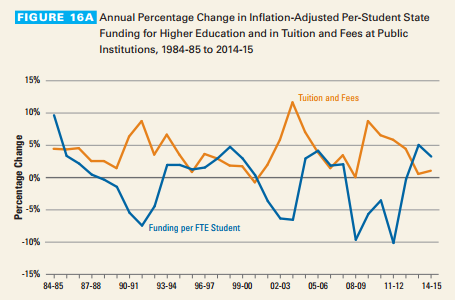By HOPE PATTI
Lack of state funding in higher education and increased tuition are continual problems colleges face, according to speakers kicking off Ramapo’s Higher Education Awareness week.
Ramapo student trustee, Josef Weikl, moderated the panel at the Feb. 22 event. President Peter Mercer, Michael Klein, the CEO of the New Jersey Association of State Colleges and Universities, A.J. Sabath, a member of Ramapo’s Board of Trustees and Kirsten DaSilva, Ramapo’s Vice President of Administration and Finance sat on the panel.
Klein informed students on the changes in higher education funding over the past two decades. “I looked back at the state budget from 25 years ago and saw that we are getting less now than we were then and that doesn’t account for inflation.”
“What you want to look at is state funding from 10 to 15 years ago, it was much greater, now we have allowed parents and students to pick up the slack,” Mercer said.

According to College Board, colleges throughout the country have faced a steady increase in tuition and decrease in state funding. State funding per full-time student, also called a full-time equivalent, has decreased from $10,110 in 2000 to $7,540 in 2014. Funding per $1000 in personal income has decreased from $7.36 in 2000 to $5.55 in 2014. Each year tuition increases by approximately 3 percent
The panel noted the effects that Governor Christie’s State of the Budget address will have on Ramapo. At Ramapo, state funding has decreased from 50 percent to 25 percent in the last 10 years. The decrease in funding from the state attributes to increasing tuition rates and student debt.
Weikl asked the panel about the low ratio of funding per student. Mercer said Ramapo is ranked the third lowest higher education institution in per capita funding in New Jersey. He also said that there is not enough emphasis on higher education. When looking at the allocation of state funds for education K-12 education is in the top 5 percent and higher education institutions are in the bottom 5 percent.
The rising cost of higher education influences a student’s decision to attend college and effects those who are leaving school with a large amount of debt. The affordability of higher education is an issue on many politicians agendas. Presidential candidate Bernie Sanders is popular with millennials for his plan to make college tuition free and debt free.
Klein noted that tuition used to be 70 percent paid by state funding and 30 percent paid by the student, something that many are not able to remember due to the increase in tuition over the last few years.

More Events This Week
There will be events taking place everyday throughout the week to address and inform students on the importance of being cognizant to issues in higher education.
Tuesday will feature a debate on higher education followed by a speech from Senator Nellie Pou on Wednesday during which she will discuss the state of higher education in New Jersey. On Thursday Alec Weissman, president of the student government association, and Josef Weikl will give their State of the Student Address.
Higher education awareness week will conclude on Friday with a voter registration drive hosted by the Black Student Union.
Great article. Some things I learned are that tuition for colleges in the U.S. increase by 3% every year, Ramapo’s decrease in state funding from 50% to 25% in the last 10 years, and that this week is in fact a Higher Education Awareness Week. This story addressed an event and covered an issue. No audio element was found.